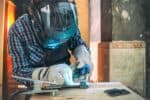Welding involves risks of fire, sparks, electric shocks, fumes and heat. Therefore, wearing right type of apron is a must while you are welding. That very clothing is supposed to safeguard you from all the aforesaid welding hazards.
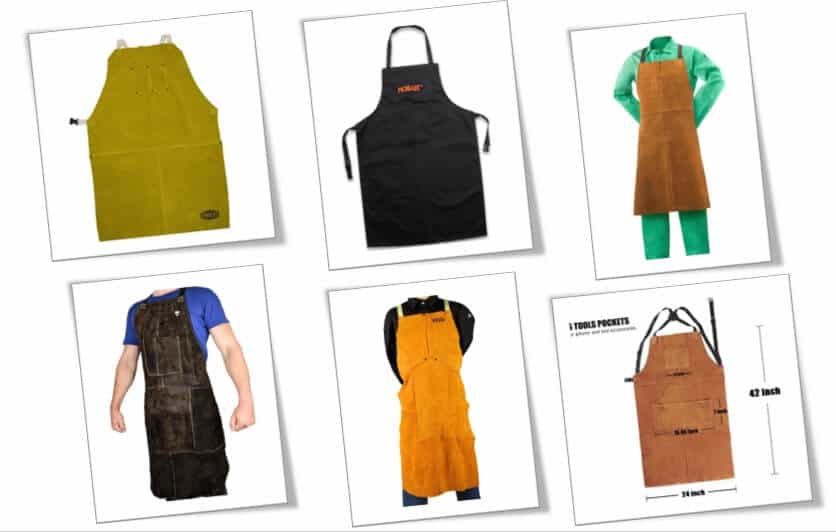
To be very precise, any 100% leather apron would work great for protection against welding. But then, the best protection is offered by the aprons made from cotton that are treated with flame retardant coatings.
Down the article, we will learn more about use of aprons while welding, why wear them? Which type of clothing to be avoided while welding, how should an apron fit, PPE for welding and many more such points that are essential for you to know!
Why wear an apron while welding?
While welding you need to deal with intense heat, electricity, flame, gas, cutting tools, heavy machinery, etc. So, wearing a protective apron is mandatory while you are welding. Welding aprons will save you from:
-
-
- Electric arc
- Heat
- Flames
- Cuts
- Burns
-
You should always wear a welding apron because of the following reasons:
-
-
- Welding aprons make sure that your clothing won’t ignite when sparks suddenly fly
- Welding aprons do not let the heat from the flames to get to your body
- Welding aprons protect you from getting cut from any sharp cutting tools
- Welding aprons do not let electric current to pass through your body
- All in all wearing an apron while welding saves you from the hot metal flakes, slag and flames that is generated while welding.
-
Types of Apron while Welding
There are various types of aprons that are worn while welding. Let’s find out about their types:
1. The full apron:
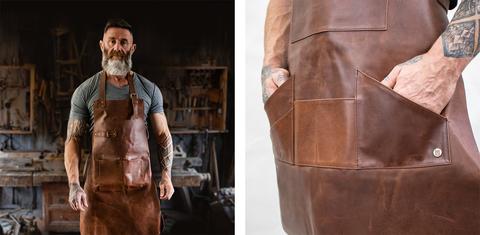
The full aprons cover your entire front from the neck to the bottom and are considered to be the safest as it gives a full coverage.
2. The half apron:
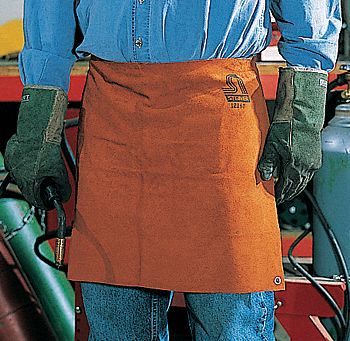
The Half aprons cover only your lower portion from the welding sparks and flames.
3. Cowhide aprons:
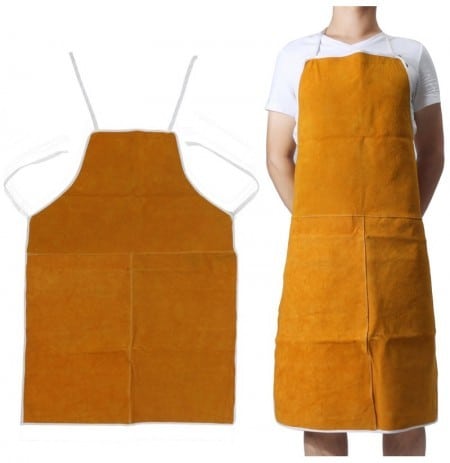
These aprons are made from the cowhide and are considered to be great while welding as they have heat retardant capacity.
4. Pig skin apron:
Most of the welding aprons are made from the skin of the pigs that are extremely durable and provide utmost protection from the welding tasks.
5. Heavy denim aprons:
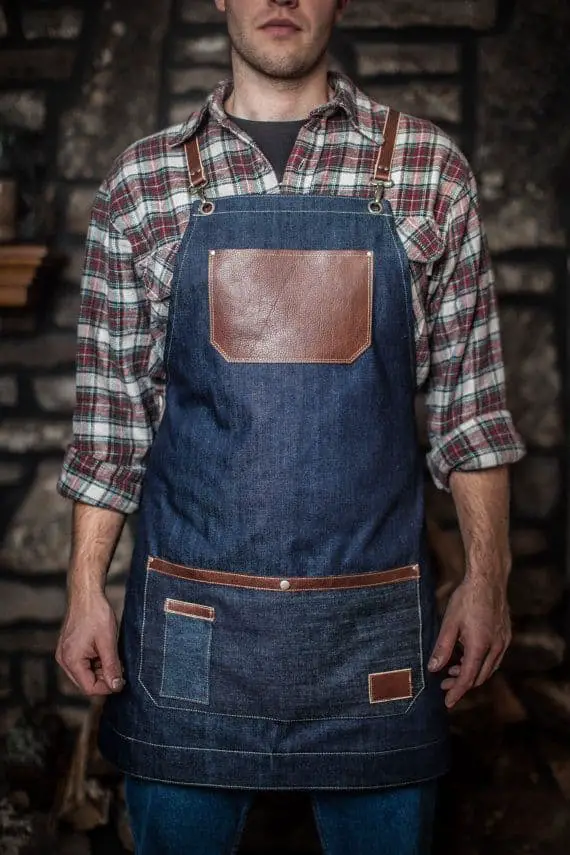
These are the most recent innovations in welding aprons and are considered being of high quality. They are comfortable, breathable and provide excellent protection against welding tasks.
6. Cotton aprons:
These are flame retardant cotton aprons that provide better protection from high heat and open flames.
What should you not wear while welding?
Clothing made of polyester, acetate or acrylic with cotton blend should be avoided as these materials catch flames and get ignited easily. Also, they will melt onto your skin in case of burns.
What is the use of leather apron in welding?
Leather is basically hardened animal skin that provides protection from the environment to the wearer.
The leather aprons are so designed that they offer full protection against welding hazards like flying molten metals, glowing particles, intense heat, sparks and electric arcs.
The full leather aprons provide protection to the wearer’s chest area, abdomen, and thigh area and also to all the internal systems that might get affected due to the intense heat generated during the welding process.
Leather aprons are also cut resistant and do not ignite easily.
What type of clothing is referred when welding?
While you are welding you must consider wearing the following types of clothing:
-
-
- Long sleeved shirts to protect your entire arms
- Collared shirts to protect your neck area
- The cuffs of the shirt should be buttoned so that no flakes can enter through them
- Light colored clothing will attract less heat
- Shirts that have flap pockets so that the pockets do not collect remains of flying hot molten metals
- Pants with belts should be worn
- The bottom of the pants should cover the boots so that no area of the upper feet remain exposed to the flames or the heat
-
What PPE should be worn by welders?
We have provided a chart below that summarizes all the essential PPE that must be used while you are welding:
| Body parts | PPE | Why wear? |
| Eyes | Safety glasses or goggles that are compliant with ANSI/ISEA Z87.1-1989 | It protects from radiation, flying molten metals, hot slag, sparks, intense heat, chemical burns |
| Face | Face shields, hand shield that are compliant with ANSI Z87.1-1989 | It protects from radiation, flying molten metals, hot slag, sparks, intense heat, chemical burns |
| Head | Welding helmets that are compliant with ANSI Z89.1-1986 | It protects from any welding hazards such as falling of loads, heats, burns, flames, radiation, cuts |
| Respiratory system | Respirators that complies with OSHA 29 CFR 1910.134 | It provides protection against fumes and oxides |
| Body skin | Fire resistant clothing, aprons, jackets | It protects from radiation, flying molten metals, hot slag, sparks, intense heat, chemical burns |
| Ears | Ear plugs and muffs | Protects against noise over 85dBA |
| Hands | Safety gloves must be ANSI/ISEA 105 rated that are cut resistant and electric arc flash resistant | Protects against cuts, burns, electric shocks, flames, heat |
| Feet | Boots that are compliant with ANSI Z41.1-1991 or ASTM F2413-05 | Protects against electric shock, heat, burns, cuts, falling of heavy objects |
Do you need a welding apron?
It entire depends on the risk factor involved in your welding work and the amount of experience you have gathered.
If you are an experienced and only do welding works like joining two metal rods, you might not need a welding apron, only cotton clothing will do the job.
But, if you are involved in fabrication process, you definitely need a welding apron while building a machine.
Which is better? Welding jacket or apron?
If you are involved in heavy welding tasks that involves working with high flames, intense heat, cutting tools, oxides, etc. you definitely need a welding jacket because they are much sturdier and offer greater protection to your body than an apron.
How should an apron fit?
In simple words, your apron should just fit comfortably to your body considering the fact that the apron has covered your entire front from the welding sparks and heat.
However, let me demonstrate you the perfect way to wear your apron so that it fits perfectly:
-
-
- Cover your front body with the apron ensuring that no vulnerable is left open
- Tie the waist drawstrings behind you just enough to make you feel comfortable and let you breathe freely and move your body. It should not be too tight at the waist area
- If your apron has a knot in the neck area, then tie it not too loose or too tight to ensure that your neck does not hurt
-
Let’s bid our Goodbyes!
Just remember that your safety is our priority and that is why we recommend the best tips for your safety at your work!
Wear your apron and save yourself from any welding hazard!
That said, it’s time to take leave from this article. Stay connected with us for more tips on welding safety measures!
Till then, take care, stay safe and…
And enjoy your welding!





